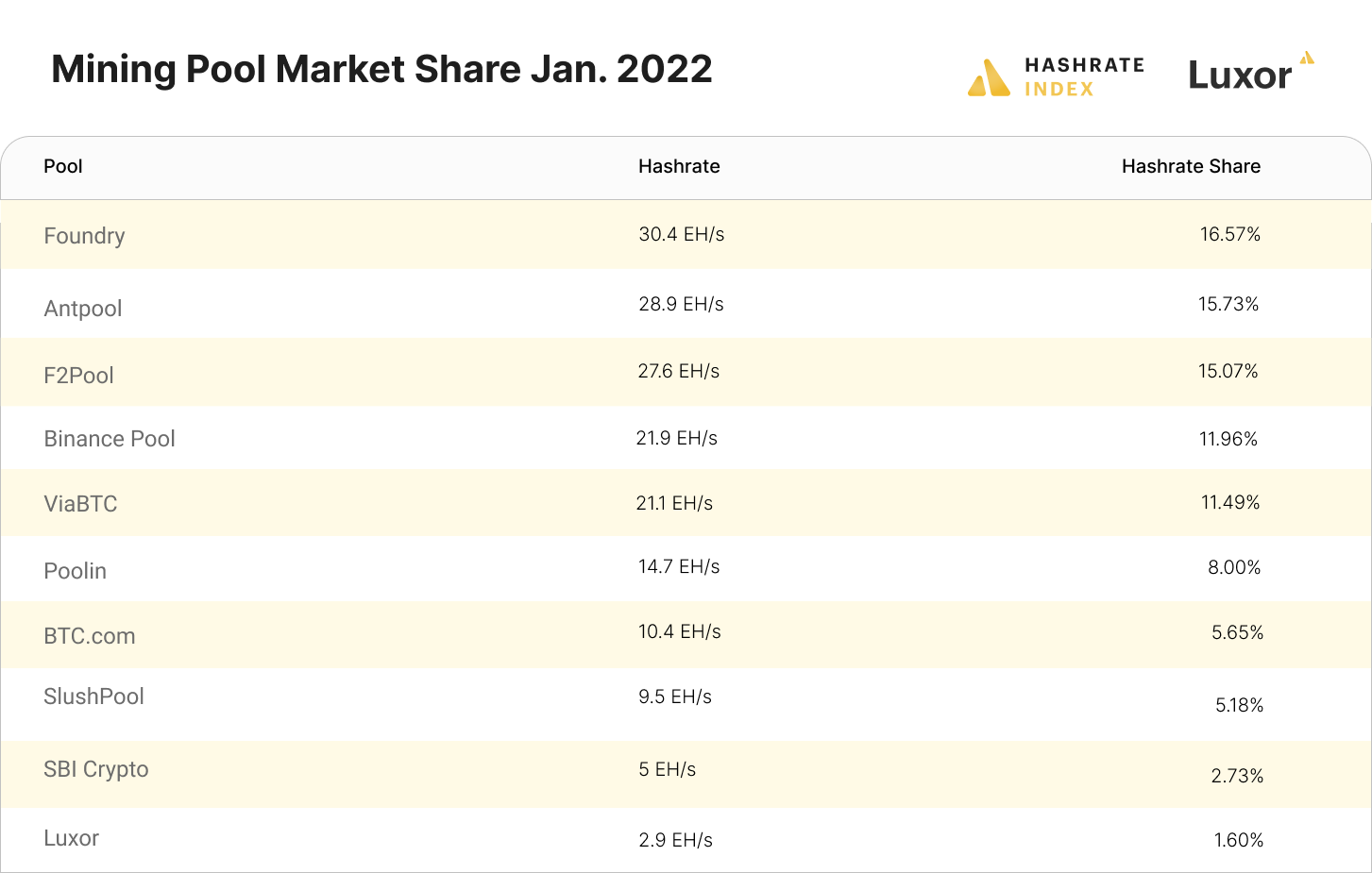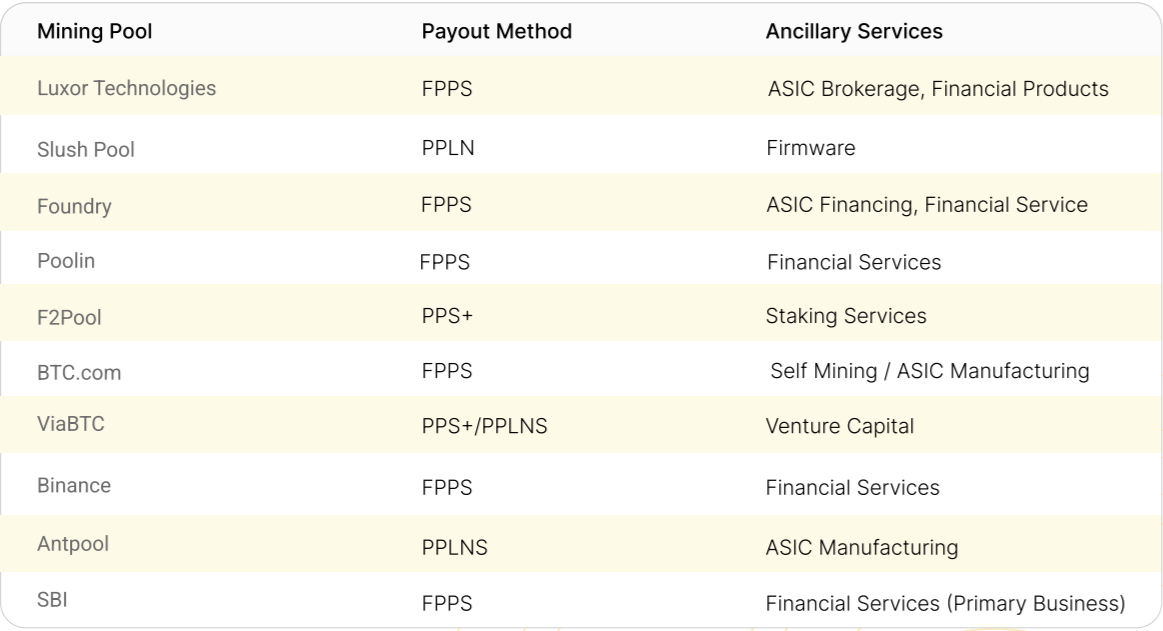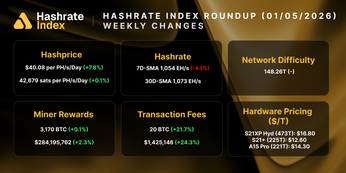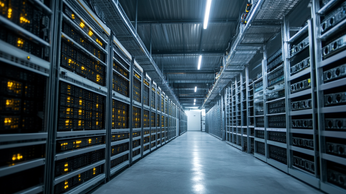
What Are Bitcoin Mining Pools? Bitcoin Mining Pool Guide
What are Bitcoin mining pools, how do mining pools work, and what will they look like in the future?
As Bitcoin mining has shifted from utilizing CPUs to GPUs to FPGAs and eventually to highly efficient ASICs, hashrate has surged, making it increasingly difficult for small, mid-size, or even large miners to mine a block individually. The low probability of an individual miner finding a block prevents participants from securing a steady stream of revenue to pay back initial machine costs and operational costs like electricity.
This is where mining pools come into play. When using a pool, miners coordinate their hardware to send compute power (hashrate) to a pool’s servers. Pools quantify valid submissions of work as ‘shares’ and pay miners for their hashrate according to how many shares they submit in a given timeframe..
Pooling hashrate together increases the probability of finding a block, where miners are paid proportionally according to the percentage of hashrate they supply to the pool. The pool collects the block reward and then makes a payment to a miner proportional to the number of shares they supplied to the pool for that payout period. Mining pools typically take a 0-3% fee for this service and use various methods for quantifying miner payouts.
Pools provide miners a steady stream of revenue, rather than leaving them to face the possibility of not finding a block for extended periods of time, and they have become an essential part of the mining ecosystem.
Bitcoin Mining Pool Payment Methods
As mining pools have evolved, they have devised different payout methods for paying their users. Some of the most popular methods are as follows:
Pay Per Share (PPS)
The PPS method provides individual miners with guaranteed payouts from the block reward based on the proportion of hashrate they provide to the pool. The risk is transferred to the mining pool: if the pool has bad luck for a continuous period, they may incur financial losses, but if the pool has good luck, then they earn a greater profit. This method does not include transaction fees as part of individual miner payout.
Full Pay Per Share (FPPS)
The FPPS method is similar to PPS, except the payout to miners consists of both the block reward and transaction fees. This is the most popular method, with 50.2% of hashrate belonging to pools utilizing this method.
Pay Per Last N Shares (PPLNS)
The PPLNS method pays miners based on the hashrate a miner has contributed over the last N epochs. The method is advantageous for miners that have been a part of the pool for a longer duration as new miners receive a smaller amount. Unlike FPPS this model only requires pools to payout when blocks are actually found, not if it is statistically probable. Similar to the FPPS method the payout consists of the block reward and transaction fees.
Pay Per Share Plus (PPS+)
The PPS+ method is a mixture of PPS and PPLNS. Shares of the block subsidy are rewarded to miners based on PPS. Shares of the transaction fees are rewarded based on PPLNS. As seen below, 26.2% of Bitcoin's hashrate belongs to pools utilizing this method, while the majority use FPPS.
China Mining Ban, Rise of North American Pools Alters Mining Pool Landscape
At the beginning of 2021, the top seven pools were based in China with over 80% of hashrate belonging to these Chinese pools. Historically, Chinese mining operations controlled a large majority of both bitcoin hashrate and mining pools. This changed drastically after May 2021, when the Chinese government announced an outright ban on bitcoin mining. Bitcoin’s network hashrate dropped by over 50% from its peak following the ban as Chinese miners unplugged machines and migrated out of the country.
The dramatic decline in hashrate opened up a golden era of profitability for North American miners, catapulting both North American public miners and pools alike to the forefront of the industry. For example, two North American mining pools, Foundry and Luxor, have emerged as top 10 pools over the past year, whereas both were outside the top 10 at the beginning of 2021.


As North American mining companies continue to go public and bulk up their hashrate, domestic pools will continue to flourish as well. North American miners may favor a North American pool because, in the case of a legal dispute, the United States in Canada have strong legal systems (and it would be much easier to take a dispute to court when compared to other jurisdictions like China). Additionally, since they are in the same region, these miners have a better chance to connect with the mining pools for support or to express concerns. Paired with this, directing hashrate to a North American pool diminishes the chances of DNS attacks from hostile governments, such as the attack the Chinese government conducted in November 2021.
The Race to Zero, Secondary Services, and the Future of Bitcoin Mining Pools
An increasingly competitive pool landscape will likely drive fees toward zero as pools attempt to attract miners with favorable rates.
In order to recover lost revenue from instituting a low fee structure, pools have begun offering secondary products to attract miners. As seen below, pools now offer a variety of ancillary services to pool participants including ASIC brokerage, financial services, and consulting. Some pools such as Foundry require miners to join their pool if an operation finances ASICs with them. This is similar to Bitmain’s past practice of mandating that its customers use Antpool, except for the fact that ASIC manufacturing was and is Bitmain’s primary revenue stream.

In the coming years, some pool operators may shift towards offering a low/no fee pool that is simply a value add to other services the business provides. Pools that build out a full product stack that includes ASIC brokerage, ASIC financing, certified repair services, hosting, and operational consulting where users must join the pool to have access to the services may be one model that pools explore to form new streams of revenue and acquire new customers.
It is important to note that running a pool is not a cheap venture. The pool operator must front hefty server costs and staff a full team of engineers to ensure 100% uptime, so the additional services these pools offer must be able to significantly offset the costs of low-fee revenue in both the short and long term. Given the increased financialization of mining, pools that offer large financial and operational services to participants may continue to thrive and expand with the pool service just being one added benefit of the business.
Header image by Raphaël Biscaldi via Unsplash
Hashrate Index Newsletter
Join the newsletter to receive the latest updates in your inbox.






